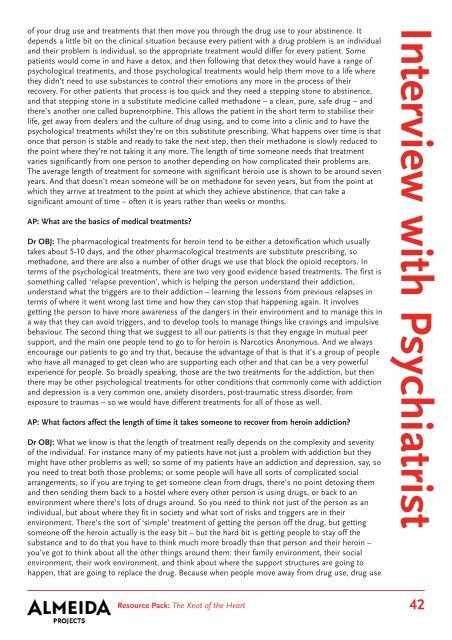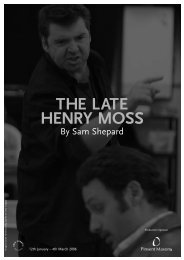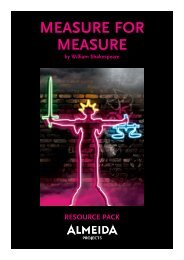KNOT HEART - Almeida Theatre
KNOT HEART - Almeida Theatre
KNOT HEART - Almeida Theatre
- No tags were found...
Create successful ePaper yourself
Turn your PDF publications into a flip-book with our unique Google optimized e-Paper software.
of your drug use and treatments that then move you through the drug use to your abstinence. Itdepends a little bit on the clinical situation because every patient with a drug problem is an individualand their problem is individual, so the appropriate treatment would differ for every patient. Somepatients would come in and have a detox, and then following that detox they would have a range ofpsychological treatments, and those psychological treatments would help them move to a life wherethey didn’t need to use substances to control their emotions any more in the process of theirrecovery. For other patients that process is too quick and they need a stepping stone to abstinence,and that stepping stone in a substitute medicine called methadone – a clean, pure, safe drug – andthere’s another one called buprenorphine. This allows the patient in the short term to stabilise theirlife, get away from dealers and the culture of drug using, and to come into a clinic and to have thepsychological treatments whilst they’re on this substitute prescribing. What happens over time is thatonce that person is stable and ready to take the next step, then their methadone is slowly reduced tothe point where they’re not taking it any more. The length of time someone needs that treatmentvaries significantly from one person to another depending on how complicated their problems are.The average length of treatment for someone with significant heroin use is shown to be around sevenyears. And that doesn’t mean someone will be on methadone for seven years, but from the point atwhich they arrive at treatment to the point at which they achieve abstinence, that can take asignificant amount of time – often it is years rather than weeks or months.AP: What are the basics of medical treatments?Dr OBJ: The pharmacological treatments for heroin tend to be either a detoxification which usuallytakes about 5-10 days, and the other pharmacological treatments are substitute prescribing, somethadone, and there are also a number of other drugs we use that block the opioid receptors. Interms of the psychological treatments, there are two very good evidence based treatments. The first issomething called ‘relapse prevention’, which is helping the person understand their addiction,understand what the triggers are to their addiction – learning the lessons from previous relapses interms of where it went wrong last time and how they can stop that happening again. It involvesgetting the person to have more awareness of the dangers in their environment and to manage this ina way that they can avoid triggers, and to develop tools to manage things like cravings and impulsivebehaviour. The second thing that we suggest to all our patients is that they engage in mutual peersupport, and the main one people tend to go to for heroin is Narcotics Anonymous. And we alwaysencourage our patients to go and try that, because the advantage of that is that it’s a group of peoplewho have all managed to get clean who are supporting each other and that can be a very powerfulexperience for people. So broadly speaking, those are the two treatments for the addiction, but thenthere may be other psychological treatments for other conditions that commonly come with addictionand depression is a very common one, anxiety disorders, post-traumatic stress disorder, fromexposure to traumas – so we would have different treatments for all of those as well.AP: What factors affect the length of time it takes someone to recover from heroin addiction?Dr OBJ: What we know is that the length of treatment really depends on the complexity and severityof the individual. For instance many of my patients have not just a problem with addiction but theymight have other problems as well; so some of my patients have an addiction and depression, say, soyou need to treat both those problems; or some people will have all sorts of complicated socialarrangements, so if you are trying to get someone clean from drugs, there’s no point detoxing themand then sending them back to a hostel where every other person is using drugs, or back to anenvironment where there’s lots of drugs around. So you need to think not just of the person as anindividual, but about where they fit in society and what sort of risks and triggers are in theirenvironment. There’s the sort of ‘simple’ treatment of getting the person off the drug, but gettingsomeone off the heroin actually is the easy bit – but the hard bit is getting people to stay off thesubstance and to do that you have to think much more broadly than that person and their heroin –you’ve got to think about all the other things around them: their family environment, their socialenvironment, their work environment, and think about where the support structures are going tohappen, that are going to replace the drug. Because when people move away from drug use, drug useInterview with PsychiatristResource Pack: The Knot of the Heart 42
















